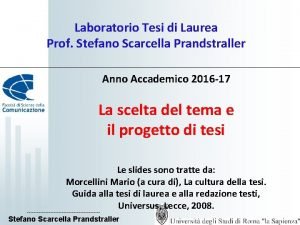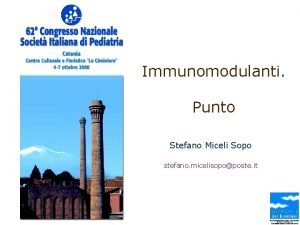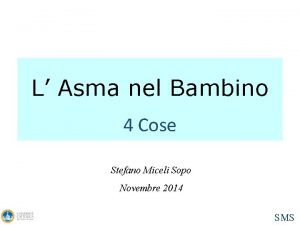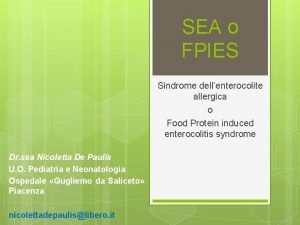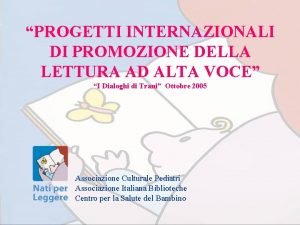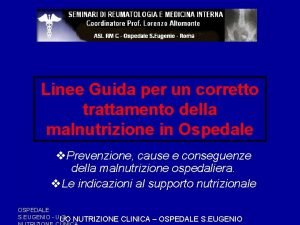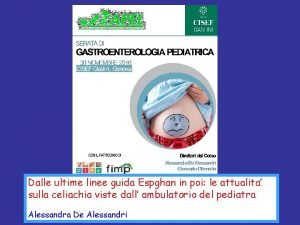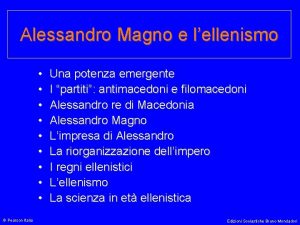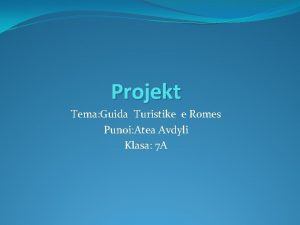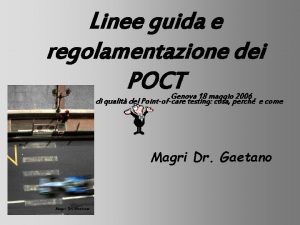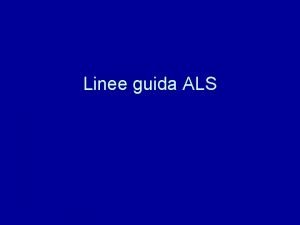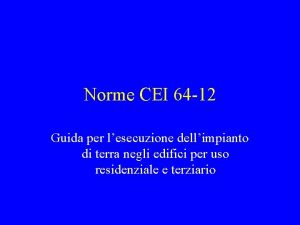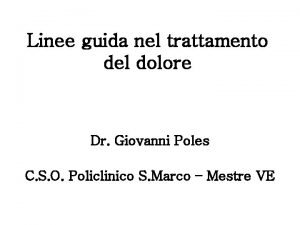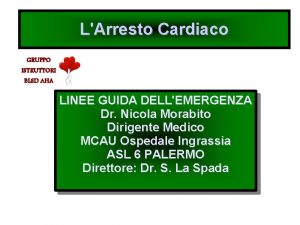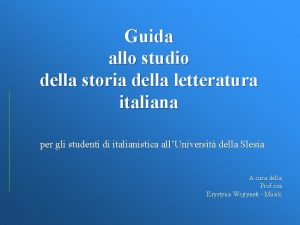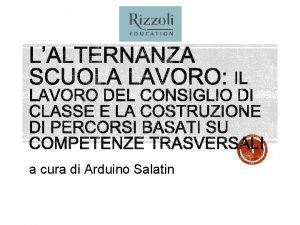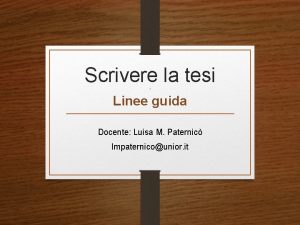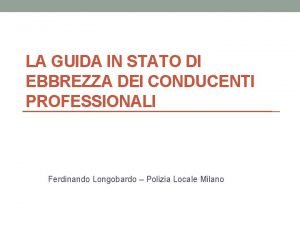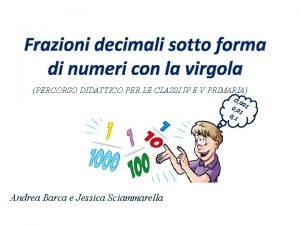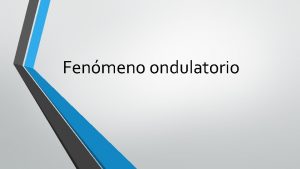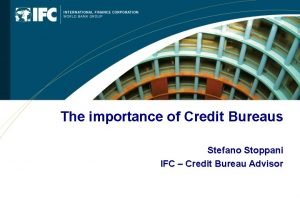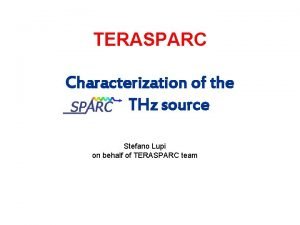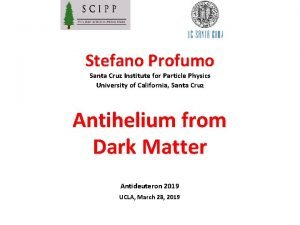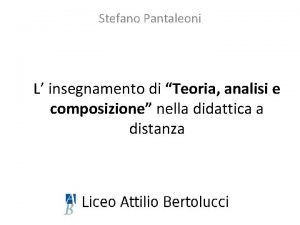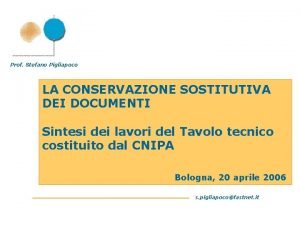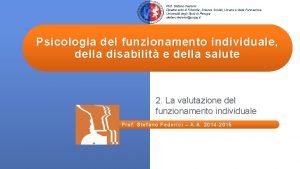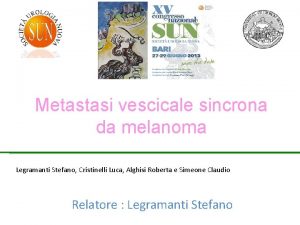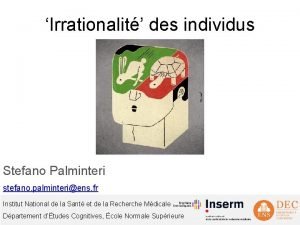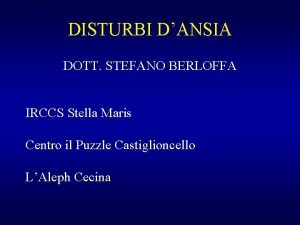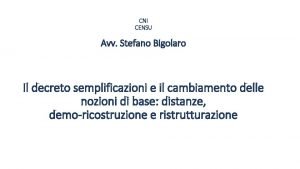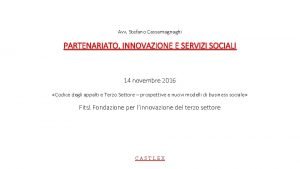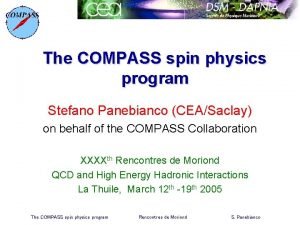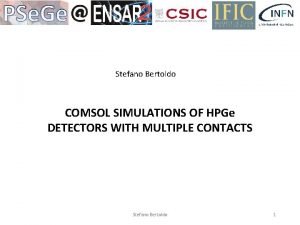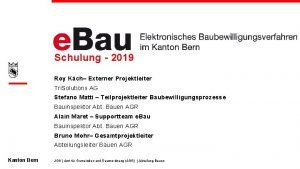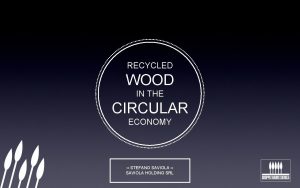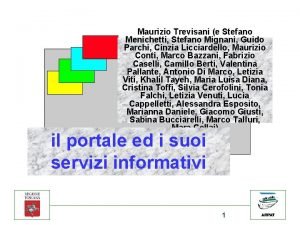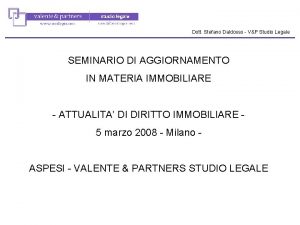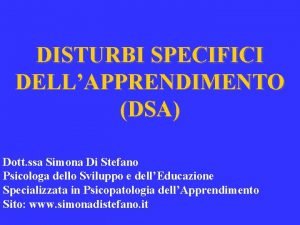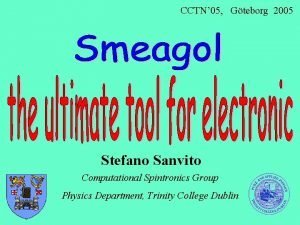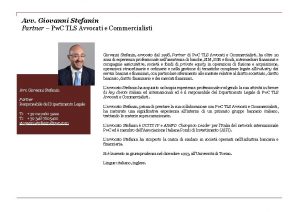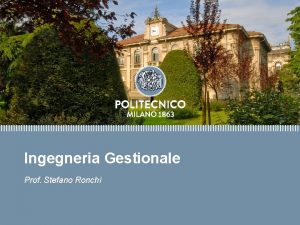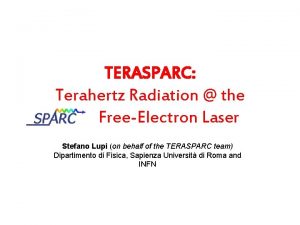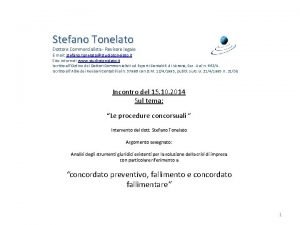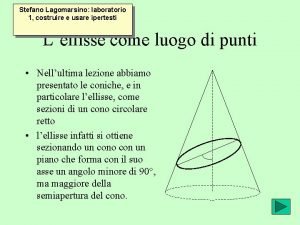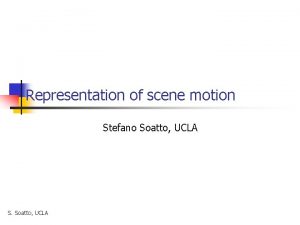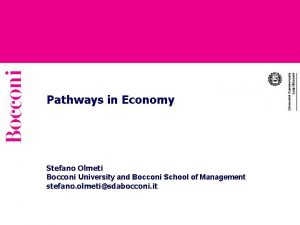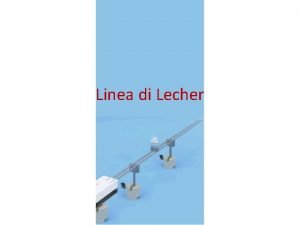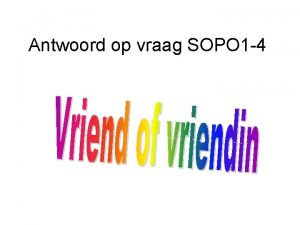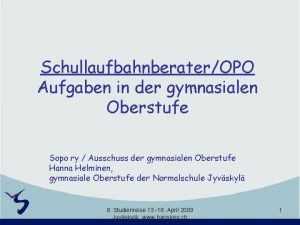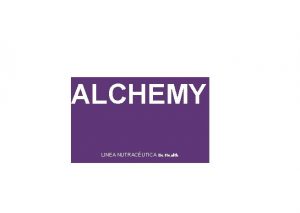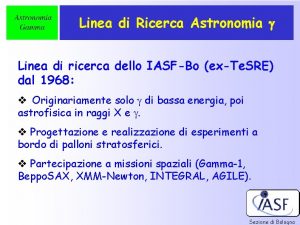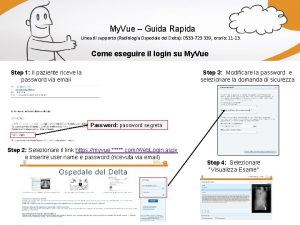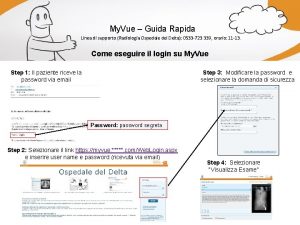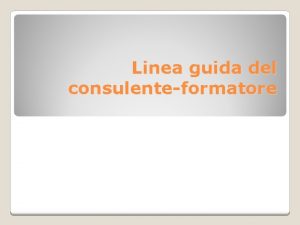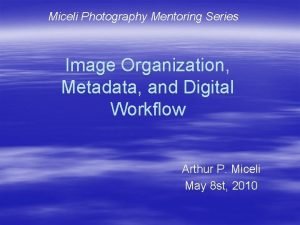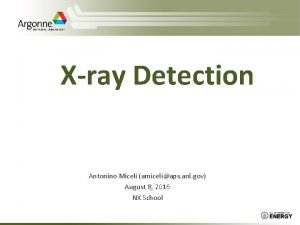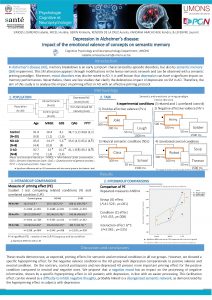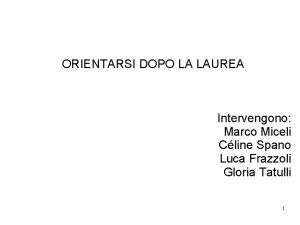LEGGERE UNA LINEA GUIDA Stefano Miceli Sopo 16



































































- Slides: 67

LEGGERE UNA LINEA GUIDA Stefano Miceli Sopo 16 Gennaio 2008

Lo Strumento • The purpose of the Appraisal of Guidelines Research & Evaluation (AGREE) Instrument is to provide a framework for assessing the quality of clinical practice guidelines • Clinical practice guidelines are ‘systematically developed statements to assist practitioner and patient decisions about appropriate health care for specific clinical circumstances’ • Their purpose is ‘to make explicit recommendations with a definite intent to influence what clinicians do’

Lo Strumento - bis • By quality of clinical practice guidelines we mean the confidence that the potential biases of guideline development have been addressed adequately and that the recommendations are both internally and externally valid, and are feasible for practice – This process involves taking into account the benefits, harms and costs of the recommendations, as well as the practical issues attached to them – Therefore, the assessment includes judgements about the methods used for developing the guidelines, the content of the final recommendations, and the factors linked to their uptake

Lo Strumento - tris • The AGREE Instrument assesses both the quality of the reporting, and the quality of some aspects of recommendations – It provides an assessment of the predicted validity of a guideline, that is the likelihood that it will achieve its intended outcome – It does not assess the impact of a guideline on patients’ outcomes

L’ Impatto sul Paziente

Sarebbe meglio fare così • Appraisers should attempt to identify all information about the guideline development process prior to appraisal • This information may be contained in the same document as the recommendations or it may be summarised in a separate technical report, in published papers or in policy reports (e. g. guideline programmes) • We recommend that you read the guideline and its accompanying documentation fully before you start the appraisal

Struttura dell’ Agree

Il Voto • Dobbiamo emettere un giudizio – Facciamo un test in cieco

La Somma • It is not possible to set thresholds for the domain scores to mark a ‘good’ or ‘bad’ guideline.

Oltre ai numeri • Si possono inserire anche dei commenti

L’ Oggetto • GUIDELINE TITLE – Evidence-based clinical practice guideline for medical management of bronchiolitis in infants less than 1 year of age presenting with a first time episode. • BIBLIOGRAPHIC SOURCE(S) – Cincinnati Children's Hospital Medical Center. Evidence based clinical practice guideline for medical management of bronchiolitis in infants less than 1 year of age presenting with a first time episode. Cincinnati (OH): Cincinnati Children's Hospital Medical Center; 2006 May. 13 p. [85 references]

SCOPO E INTENZIONI - 1

GUIDELINE OBJECTIVE(S) • In children age less than 12 completed months and presenting for the first time episode with bronchiolitis typical in presentation and clinical course, the objectives of this guideline are to: – Decrease the use of unnecessary diagnostic studies – Decrease the use of medications and respiratory therapy without observed improvement – Improve the rate of appropriate admission – Decrease the rate of nosocomial infection – Improve the use of appropriate monitoring activities – Decrease length of stay

SCOPO E INTENZIONI - 2

INTERVENTIONS AND PRACTICES CONSIDERED

SCOPO E INTENZIONI - 3

TARGET POPULATION • These guidelines are intended for use in children: Age less than 12 completed months and presenting for the first time episode with bronchiolitis typical in presentation and clinical course • These guidelines are not intended for use in children: – With a history of cystic fibrosis (CF) – With a history of bronchopulmonary dysplasia (BPD) – With immunodeficiencies – Admitted to an intensive care unit – Requiring ventilator care – With other severe comorbid conditions complicating care

COINVOLGIMENTO DEGLI INTERESSATI - 1

Bronchiolitis Team Members 2005 • Community Physician: *Chris Bolling, MD, Chair, Community Physician • Cincinnati Children's Hospital Medical Center Physicians: *Michael Farrell, MD, Gastroenterology, Chief of Staff; *Scott Reeves, MD, Emergency Medicine; Julia Kim, MD, Chief Resident; Indi Trehan, MD, MPH, Resident; Amy Cenedella, MD, Chief Resident • Nursing/Patient Services: *Shirley Salway, RN, Inpatient Unit • Respiratory Therapy: *Scott M. Pettinichi, MEd, RRT, RCP (Clinical Director, Respiratory Care); *Edward Conway, RRT (Certified Asthma Educator) • Division of Health Policy Clinical Effectiveness Support: Edward Donovan, MD, Neonatology, Med. Dir. , Clin. Eff. ; *Kieran Phelan, MD, General Pediatrics; *Eloise Clark, MPH, MBA, Facilitator; Eduardo Mendez, RN, MPH, Dir. Evidence Based Care; Detrice Barry, RN, MSN, Education Coordinator; Deborah Hacker, RN, Medical Reviewer; *Kate Rich, Analyst • All Team Members and Clinical Effectiveness support staff listed above have signed a conflict of interest declaration. • Ad hoc Advisors: *Beverly Connelly, MD, Infectious Diseases, Assistant Director; *Richard Ruddy, MD, Emergency Medicine, Director; *Dorine Seaquist, RN, Patient Services, Senior VP; Mel Rutherford, Esq. Risk Management & Corp. Compliance; *Barbarie Hill, Manager, Pratt Library • * Member of previous Bronchiolitis Team

COINVOLGIMENTO DEGLI INTERESSATI - 2

PATIENT RESOURCES • The following Health Topics are available: – – – Bronchiolitis -- essential facts Bronchiolitis Suctioning the nose with a bulb syringe Second hand smoke dangers Bronchiolitis: patient/family pathway • We urge patients and their representatives to review this material and then to consult with a licensed health professional for evaluation of treatment options suitable for them as well as for diagnosis and answers to their personal medical questions

COINVOLGIMENTO DEGLI INTERESSATI - 3

INTENDED USERS • • Advanced Practice Nurses Allied Health Personnel Health Care Providers Nurses Patients Physician Assistants Physicians Respiratory Care Practitioners • CLINICAL SPECIALTY – Emergency Medicine – Family Practice – Pediatrics

COINVOLGIMENTO DEGLI INTERESSATI - 4

DESCRIPTION OF IMPLEMENTATION STRATEGY • Appropriate companion documents have been developed to assist in the effective dissemination and implementation of the guideline • IMPLEMENTATION TOOLS – – Chart Documentation/Checklists/Forms Clinical Algorithm Patient Resources Quick Reference Guides/Physician Guides

RIGORE METODOLOGICO - 1

METHODS USED TO COLLECT/SELECT EVIDENCE • Searches of Electronic Databases

DESCRIPTION OF METHODS USED TO COLLECT/SELECT THE EVIDENCE • To select evidence for critical appraisal by the group, the Medline, Em. Base, and the Cochrane databases were searched for dates of October 2001 through October 2004 to generate an unrefined, "combined evidence" database using a search strategy focused on answering clinical questions relevant to bronchiolitis and employing a combination of Boolean searching on human-indexed thesaurus terms (Medical Subject Heading [Me. SH] headings using an OVID Medline interface) and "natural language" searching on words in the title, abstract, and indexing terms. The citations were reduced by eliminating duplicates, review articles, non. English articles, and adult articles. The resulting abstracts were reviewed by a methodologist to eliminate low quality and irrelevant citations. • During the course of the guideline development and revision, additional clinical questions were generated and subjected to the search process, and some relevant review articles were identified

NUMBER OF SOURCE DOCUMENTS • 238

RIGORE METODOLOGICO - 2

METHODS USED TO ASSESS THE QUALITY AND STRENGTH OF THE EVIDENCE • Not stated

RATING SCHEME FOR THE STRENGTH OF THE EVIDENCE • Not applicable

METHODS USED TO ANALYZE THE EVIDENCE • Review of Published Meta-Analyses

DESCRIPTION OF THE METHODS USED TO ANALYZE THE EVIDENCE • Not stated

RIGORE METODOLOGICO - 3

METHODS USED TO FORMULATE THE RECOMMENDATIONS • Expert Consensus

DESCRIPTION OF METHODS USED TO FORMULATE THE RECOMMENDATIONS • Recommendations have been formulated by a consensus process directed by best evidence, patient and family preference, and clinical expertise. During formulation of these recommendations, the team members have remained cognizant of controversies and disagreements over the management of these patients. They have tried to resolve controversial issues by consensus where possible and, when not possible, to offer optional approaches to care in the form of information that includes best supporting evidence of efficacy for alternative choices

RIGORE METODOLOGICO - 4

BENEFITS/HARMS OF IMPLEMENTING THE GUIDELINE RECOMMENDATIONS • POTENTIAL BENEFITS – Decreased use of unnecessary diagnostic studies – Decreased use of medications and respiratory therapy without observed improvement – Improved rate of appropriate admission – Decreased rate of nosocomial infection – Improved use of appropriate monitoring activities – Decreased length of stay • POTENTIAL HARMS – Wide variability has been demonstrated in the manner in which clinicians use and interpret pulse oximetry readings in children with bronchiolitis. This guideline's recommendations seek to reduce this variability in order to limit the associated increased preferences for hospital admission and increased length of stay for children admitted with bronchiolitis, – but with the trade-off of not observing or managing transient hypoxia

RIGORE METODOLOGICO - 5

TYPE OF EVIDENCE SUPPORTING THE RECOMMENDATIONS • Each recommendation is followed by evidence classification (A -X) identifying the type of supporting evidence. – It is recommended that inhalation therapy not be repeated nor continued if there is no improvement in clinical appearance between 15 to 30 minutes after a trial inhalation therapy (Klassen, 1997 [S]; Bausch & Lomb Pharmaceuticals, 1999 [O]) • Definitions for the types of evidence are presented at the end of the "Major Recommendations" field

Evidence Grading Scale • • • A: Randomized controlled trial: large sample B: Randomized controlled trial: small sample C: Prospective trial or large case series D: Retrospective analysis E: Expert opinion or consensus F: Basic laboratory research S: Review article M: Meta-analysis Q: Decision analysis L: Legal requirement O: Other evidence X: No evidence

RIGORE METODOLOGICO - 6

METHOD OF GUIDELINE VALIDATION • External Peer Review

DESCRIPTION OF METHOD OF GUIDELINE VALIDATION • The guidelines have been reviewed and approved by clinical experts not involved in the development process, senior management, Risk Management & Corporate Compliance, the Institutional Review Board, other appropriate hospital committees, and other individuals as appropriate to their intended purposes

RIGORE METODOLOGICO - 7

DESCRIPTION OF METHODS USED TO COLLECT/SELECT THE EVIDENCE • August 2001 was the last date for which literature was searched for the previous version of the guideline. The details of previous review strategies are not documented. However, all citations carried from an earlier version were reviewed for appropriateness to this revision.

May 2006 Review • A search using the above criteria was conducted for dates of November, 2004 through May, 2006. Thirty-one relevant articles were selected as potential future citations for the guideline. However, none of these references were determined to require changes to the 2005 version of the recommendations

CHIAREZZA NELLA PRESENTAZIONE - 1

Medications and Oxygen • It is recommended that inhalation therapy not be repeated nor continued if there is no improvement in clinical appearance between 15 to 30 minutes after a trial inhalation therapy – (Klassen, 1997 [S]; Bausch & Lomb Pharmaceuticals, 1999 [O]). • Note: In order to determine appropriateness of repeated therapy, use the Bronchiolitis Respiratory Sheet to record preand post-clinical score – (Conway et al. , 2004 [C]) • It is recommended to consider starting supplemental oxygen when the saturation is consistently less than 91% and consider weaning oxygen when consistently higher than 94% – (National Institutes of Health (NIH), 1997 [E]; Local Expert Consensus [E]).

CHIAREZZA NELLA PRESENTAZIONE - 2

Note 1 • Nebulized racemic epinephrine was shown to result in better improvement in pulmonary physiology and clinical scores compared with albuterol or placebo in several studies and one systematic review. These effects predominated in mildly ill children and were transient (30 to 60 minutes) in duration – (Hartling et al. , 2003 [M]; Wainwright et al. , 2003 [A]; Numa, Williams, & Dakin, 2001 [O]).

CHIAREZZA NELLA PRESENTAZIONE - 3


CHIAREZZA NELLA PRESENTAZIONE - 4

AVAILABILITY OF COMPANION DOCUMENTS • The following are available – Bronchiolitis. Guideline highlights – Bronchiolitis respiratory sheet – Emergency department algorithm • PATIENT RESOURCES – – – Bronchiolitis -- essential facts Bronchiolitis Suctioning the nose with a bulb syringe Second hand smoke dangers Bronchiolitis: patient/family pathway

APPLICABILITA’ - 1


APPLICABILITA’ - 2

COST ANALYSIS • The use of palivizumab has not been shown to be costeffective in children regardless of prematurity or the presence of congenital heart disease due to the high cost of the medication and persistently low mortality rates associated with respiratory syncytial virus (RSV)-bronchiolitis.

APPLICABILITA’ - 3

ED Algorithm Previously Healthy Infants < 12 mo who present with URI symptoms and wheezing • Care Goals: – Nebulizer trialed only if score >3 (or if <2 and family history of asthma - ED) – Inhalation therapy continued only if shown effective – RSV wash not routinely recommended – Patients are admitted appropriately

INDIPENDENZA EDITORIALE - 1

SOURCE(S) OF FUNDING • Cincinnati Children's Hospital Medical Center

INDIPENDENZA EDITORIALE - 2

FINANCIAL DISCLOSURES/CONFLICTS OF INTEREST • The guideline was developed without external funding • All Team Members and Clinical Effectiveness support staff listed have declared whether they have any conflict of interest and none were identified

GIUDIZIO FINALE
 Stefano miceli sopo curriculum
Stefano miceli sopo curriculum Stefano miceli sopo
Stefano miceli sopo Stefano miceli sopo
Stefano miceli sopo Miceli sopo criteri
Miceli sopo criteri Come leggere un codice fiscale
Come leggere un codice fiscale Pulce sulle poppe di bella donna
Pulce sulle poppe di bella donna Leggere ad alta voce
Leggere ad alta voce Glagol leggere
Glagol leggere Maria teresa miceli kerbauy
Maria teresa miceli kerbauy Reazione vincolare guida circolare
Reazione vincolare guida circolare Linee guida malnutrizione
Linee guida malnutrizione Ammonitina
Ammonitina Linee guida celiachia 2020 pdf
Linee guida celiachia 2020 pdf Guida alla propaganda pearson
Guida alla propaganda pearson Guida turistike projekt
Guida turistike projekt Linee guida poct
Linee guida poct Linee guida acls
Linee guida acls Skeppsholmen guida viaggio
Skeppsholmen guida viaggio 64-12
64-12 Viaggio di enea mappa
Viaggio di enea mappa Linee guida dolore
Linee guida dolore Linee guida blsd
Linee guida blsd Guida allo studio della storia 4
Guida allo studio della storia 4 Guida
Guida Scuola guida arduino
Scuola guida arduino Paternicò unior
Paternicò unior Guida ebbrezza
Guida ebbrezza Guida ai fondi strutturali europei 2014-2020
Guida ai fondi strutturali europei 2014-2020 Esempio di adynaton
Esempio di adynaton Una linea curva
Una linea curva Frazioni sotto forma di numeri decimali
Frazioni sotto forma di numeri decimali Una gimnasta agita una cinta con una frecuencia constante
Una gimnasta agita una cinta con una frecuencia constante Stefano stoppani
Stefano stoppani Stefano lupi
Stefano lupi Stefano profumo
Stefano profumo Maffeo pantaleoni registro elettronico
Maffeo pantaleoni registro elettronico Stefano pigliapoco
Stefano pigliapoco Vineland pronuncia
Vineland pronuncia Stefano legramanti
Stefano legramanti Stefano palminteri
Stefano palminteri Stefano tessaro
Stefano tessaro Stefano berloffa stella maris
Stefano berloffa stella maris Stefano bigolaro
Stefano bigolaro Stefano cassamagnaghi
Stefano cassamagnaghi Tamara stefano
Tamara stefano Stefano panebianco
Stefano panebianco Stefano bertoldo
Stefano bertoldo Stefano matti agr
Stefano matti agr Saviola holding
Saviola holding Stefano vignudelli
Stefano vignudelli Monachesimo eremitico
Monachesimo eremitico Stefano mignani
Stefano mignani Stefano danese
Stefano danese Stefano monti iaea
Stefano monti iaea Stefano daldosso
Stefano daldosso Simona di stefano psicologa
Simona di stefano psicologa Stefano sanvito
Stefano sanvito Stefano grazioli
Stefano grazioli Stefano dei ovi
Stefano dei ovi Giovanni stefanin
Giovanni stefanin Stefano ronchi polimi
Stefano ronchi polimi Stefano lupi sapienza
Stefano lupi sapienza Stefano tonelato
Stefano tonelato Costruire ellisse
Costruire ellisse Stefano soatto ucla
Stefano soatto ucla Stefano olmeti
Stefano olmeti Stefano balietti
Stefano balietti Types of game
Types of game
